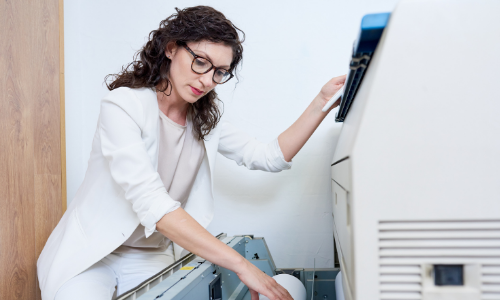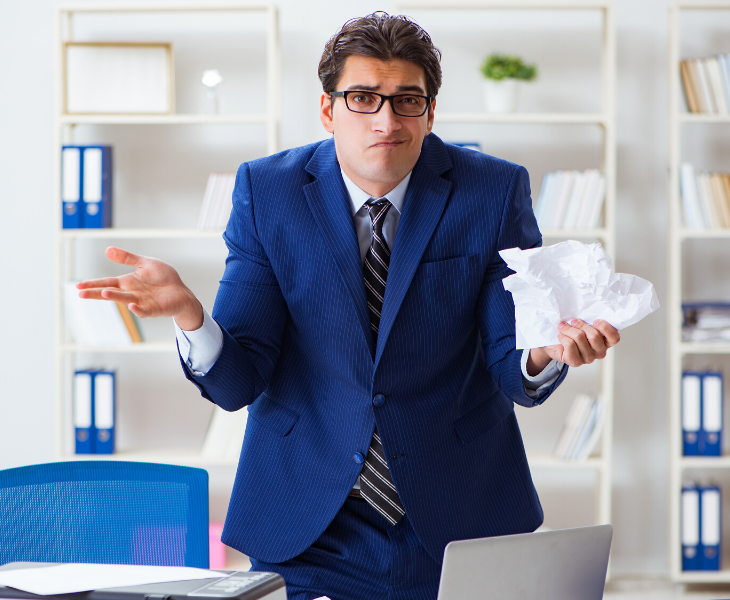Welcome to the wild world of office printing, where it can be virtually impossible to know which type of paper to choose for your office printer.
How can you tell if the paper is eco-friendly? What’s the difference between Brightness and Whiteness? And how about Grammage vs Thickness vs Stiffness? It can be confusing!
But don’t stress – we at COS have compiled this handy guide to tell you everything you’ve ever wanted to know (and even some stuff you didn’t) about choosing the right paper for your office!
Which Office Paper is Good for the Planet?
The first thing to consider is where the paper comes from.

Virgin Paper
Virgin Wood Fibre Paper is typically manufactured directly from trees, without any recycled or alternative fibres. Virgin fibres are popular because they produce whiter, higher quality paper. But if you are buying Virgin paper, it is important to choose paper that is sustainably sourced. Look for products with environmentally responsible certification, such as FSC (Forest Stewardship Council), which supports responsible forest management worldwide. These logos identify that the paper is produced from responsibly sourced materials, and minimises environmental impacts.
Some virgin paper types that are sustainable forest certified according to the FSC include the A4 COS Premium 80gsm Copy Paper and A3 COS Premium 80gsm Copy Paper.
Recycled Paper
From the manufacturing stage to the consumption stage, paper production produces paper waste. In the past, this paper waste has either been burned or buried in landfills. This is obviously pretty terrible for the environment! That’s why it is so important to buy Recycled Paper and Close the Loop (reuse and recycle). Recycled paper is measured by a percentage of Pre and Post-Consumer waste. What does this mean?
Pre-Consumer: this is paper that is recovered after the papermaking process but before use by a consumer.
Post-Consumer: these are waste materials recovered after being used by a consumer.
Some examples of recycled paper include the A4 White 80gsm 100% Recycled Paper and A3 White 80gsm 100% Recycled Paper.
Does Office Paper Have Certification?
It is important to choose paper that is sustainably certified, so that you know it has been independently approved as meeting international standards through its production and supply chain. Look for the following logos. These logos identify different things, but they all show you that environmental impacts have been minimised.
How to Choose the Right Office Paper?
Choosing your office paper seems simple enough, right? Think again! Here are some aspects to choosing the perfect paper that you may not have thought of. Don’t worry if you don’t get it all straight away!
Paper Size
The first thing to think about is your paper size. Our most popular sizes are A4 and A3. A4 is the standard size that you would usually use for printing paper (210 x 297mm), whereas A3 is roughly twice the size (297 x 430mm).
Paper Coating
-
Uncoated Paper – This paper is the most common type of paper for printing. As the name suggests, Uncoated Paper has no coating.
-
Matte Paper – This paper has a smooth light coating that adds contract to images and makes the paper feel slightly smoother.
-
Glossy Paper – This paper has a glossy coating that is thicker than standard paper, making it ideal for photos, posters and marketing materials.
-
Silk/Satin Paper – This is a high-quality smooth coating that makes the printing very vibrant in colour and sharper text.
Roughness vs. Smoothness
- Roughness – Roughness describes the surface texture of the paper. Low roughness paper is smoother and allows finer details to be printed. The higher the number, the rougher the sheet.
- Smoothness – Smoothness refers to the flatness of a sheet of paper, which generally determines the crispness of the image printed upon it. This is measured under a moderate pressure to see how the paper performs.
Other things to consider include:
-
Opacity – Opacity measures the transparency of a piece of paper (opaqueness). The more fibres or fillers in a paper, the less opaque it will be. Higher opacity ensures that the print from the opposite side of the sheet is not visible and is suited for double-sided printing.
-
Moisture – Moisture refers to the amount of water contained in paper expressed as a percentage of the paper’s total weight. Moisture loss or gain can be seen across the surface of a paper. Wavy edges or baggy edges on paper have gained moisture while tight edges have lost moisture.
The Difference Between Whiteness and Brightness
Although they might sound like the same thing, it’s important to know the difference between whiteness and brightness when it comes to paper.
CIE Whiteness
CIE Whiteness is the internationally recognised standard for measuring paper whiteness. Whiteness refers to the shade of the paper, measuring a combination of shades (blue, yellow) as well as brightness of paper surface. Many paper grades have whiteness well above 100 due to the addition of Fluorescent whitening agents. The whiter the paper the brighter the printing will be.
Brightness with UV
Brightness refers to the volume of light reflected off the sheet of paper. The brighter & whiter the paper, the better and more vivid the colour prints will be.
How Do They Make Office Paper White?
Paper does not naturally come out white, so it is necessary to whiten it. Traditionally it is whitened using Elemental Chlorine (CI) gas, which also removes Lignin, an element of wood fibre that yellows paper when it’s exposed to sunlight. However, this chemical is very dangerous to humans and the planet – and this pollution doesn’t break down naturally over time, it just accumulates in the environment. Chlorine gas is so dangerous to humans that it was actually used in World War I as a chemical weapon! Until the 1990’s, it was used in 90% of paper pulp production. Thankfully nowadays it’s more like 20%. Instead of this dangerous chemical, we use the Elemental Chlorine Free (ECF) technique to whiten our paper at COS. It’s important to choose paper that is produced using the ECF technique, because it doesn’t result in this dangerous environmental impact.
What about Grammage, Thickness and Stiffness?
I’m glad you’re still reading! Hang in there, we’ll get to the good stuff in the following paragraphs. When it comes to Grammage vs Thickness vs Stiffness, you’d be forgiven for getting confused. Read on to find out the difference.
GSM Grammage
Grammage refers to the density of paper or cardboard is the weight of the product, measured by the amount that a square metre weighs. The higher the GSM number, the heavier the paper.
Thickness
The physical Thickness of a piece of paper (Caliper) is usually expressed in thousandths of an inch. A higher caliper will have a more substantial feel and flexibility with better quality print coverage.
Stiffness
Stiffness is the ability of paper to resist an applied bending force and to support its own weight while being handled. An adequate degree of Stiffness is important to avoid distortion of the paper, and a sheet that is too limp can cause feeding problems in copiers and printers.
How to Load Office Paper into Your Printer

Now for the really useful stuff!
Loading paper into your printer is a relatively easy task, but can result in printer jams and other frustrations if done incorrectly. Follow these two easy steps for a perfect printing experience:
Click here to watch our video for handy tips on how to load your printer for the best printing experience.
1. Air out your paper before loading
Most paper is packaged at the same time it’s cut, which means that there tends to be no air in between the sheets of paper when it’s packaged. This makes it harder for your printer to load only one sheet at a time.
Air out your paper before loading into the tray, by fluffing or lightly fanning it to help separate the sheets so they feed smoothly.
2. Prevent your paper from curling
Paper is always packed with the printable side up. So, as soon as you receive your fresh box of paper, flip it over so that gravity will help to flatten it.
If you notice any curl in the paper before loading into the printer, gently but firmly bend the paper back against itself in the opposite direction.
Ensure you print on the correct side of the paper, because the heat of the fuser will counteract the natural curl of the paper and you’ll end up with a flatter sheet of paper.
Handling Office Paper and Printer Jams

Well, one thing you definitely should not do is take it out on your copy machine (as this image depicts). More likely than not, it is not the printers fault. Instead, try troubleshooting the problem before you grab that baseball bat.
Reset the memory
Your office printer is smarter than you think. Over time, if a printer has been using the same kind of paper repeatedly, the printer forms a memory for that paper. So, when you change brands or paper type, your printer may struggle to recognise the new paper, potentially causing jams and frustration. The good news is that this doesn’t mean there’s anything wrong with your printer or your new paper, the printer might simply require a service in order to reset the memory.
Check how your paper is stored
Your copy paper is actually quite sensitive. It’s made from tree pulp which is a natural resource, so it’s highly responsive to temperature and humidity changes. If your paper is stored in an unsuitable environment, you risk curling, waving, static and other issues. These can all affect how your printer interacts with each sheet and often leads to avoidable paper jams. High moisture content can affect the transfer of toner onto the paper, resulting in poor image quality or image deletions. It can also cause curling which is a common reason for paper jams. Low moisture content can contribute to increased static electricity, which means sheets can stick together and feed through the printer at once. This is also a cause of paper jams, as well as bad stacking.
How to Store Paper:
- Store paper in a cool, dry, stable climate. Paper stores best at around 20C and a relative humidity of 35 to 55 percent.
- Store away from direct sunlight
- Keep reams flat and wrapped until use
- Use up an open packet before opening a new one
- Acclimatise paper between storage and printing
Why You Need to Acclimatise Office Paper
Paper that is stored separately to your office, such as in a warehouse, basement or storage room, will need time to acclimatise before you use it. By letting it adjust, the paper has time for its moisture levels to balance. How long your paper will need to acclimatise depends on the paper quantity and the temperature difference between storage and the office. For the standard office, it could be between 13 and 30 hours.

